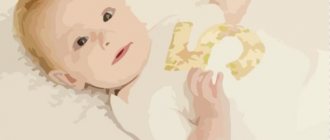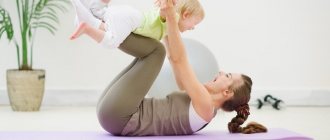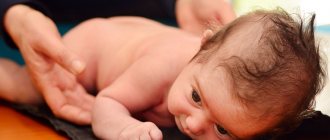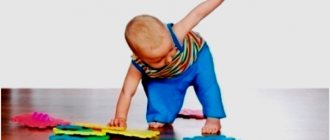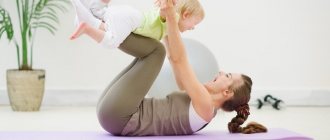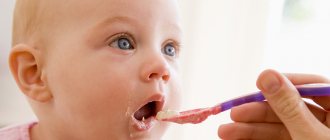Massage is prescribed for children of all ages, but children under one year of age have a special need for it. Especially due to increased muscle tone, delayed physical and mental development. Massage at 9-12 months is also prescribed for the general health of the body, as well as after illnesses.
But there are some features of this procedure that parents should consider before contacting a specialist.
Indications for massage
Children are prescribed two types of massage: restorative and therapeutic.
In the first case, the procedure is aimed at relaxation and muscle tone. You can do it regularly at home or contact a specialist. Therapeutic (medical) massage is much more serious and complex. It is prescribed by a doctor for the treatment of diseases as an auxiliary or maintenance therapy.
Professional massage at 9 months is prescribed for the following pathologies:
- hip dysplasia;
- hip dislocation;
- muscular torticollis;
- decreased or increased muscle tone;
- scoliosis;
- neurological diseases;
- spine pathologies;
- weakness of muscles and musculoskeletal system.
An important indication for several courses of massage are congenital pathologies and cerebral palsy. It complements other rehabilitation methods, including work with a psychologist.
At nine months of age, babies make attempts to walk and begin to more actively explore the world in an upright position. This requires relaxing limbs that are very tense during the day. And due to the strong emotions received at home and on walks, it is difficult for the baby to fall asleep in the evening. Massage helps children relax while strengthening their muscles for active walking.
Early development. Gymnastics and massage for a child 6-9 months
GYMNASTICS FOR A BABY 6-9 MONTHS old
- CROSING ARMS ON THE CHEST
Place your baby on his back and place your thumbs in his fists. Slowly spread your baby's arms out to the sides, then cross them over his chest and spread them out to the sides again. Perform 6-8 times.
You can accompany the exercise with the following verses:
Pull your tails.
Sip on it
In a box
Put it in.
Complication: place the rings in the baby’s hands, speed up and slow down the movements.
- "SLIDING STEPS"
The child lies on his back. Grasp your baby's legs at the bottom of the shin with your hands. Bend and straighten both legs at the same time, and then in turn. The exercise is performed 4-6 times on each leg.
- SITTING
The child lies on his back, put your index fingers in his arms and slightly pull him towards you, encouraging the baby to sit up. Then use your index and middle fingers to move along the spine from bottom to top. Do the exercise 2 times.
If the child is physically well developed, the exercise can be performed by supporting the baby by one hand and fixing the legs.
- CIRCULAR MOVEMENTS WITH YOUR HANDS
The child lies on his back. Place your thumbs in your baby's hands. Take his arms to the sides, lift them through the sides to his head, lower them forward and down. Repeat the exercise 4-6 times.
- RAISING STRAIGHT LEGS
The child lies on his back. Grasping the shins, lift the child's straightened legs to a vertical position and slowly lower them. Then alternately lift your left and then your right leg.
Repeat the exercise 6-8 times.
- TURN FROM BACK TO Stomach
After completing exercises that require lying on your back, the baby needs to be turned onto his stomach. At 6-9 months, the baby can roll over onto his stomach on his own. Accompany the exercise with the instruction: “Turn around!” or show your baby an interesting toy from the side in which he should turn.
- LIFTING THE TORSO
The child lies on his stomach. Place your thumbs in your baby's hands. Move the child's straightened arms to the sides and lift them to the head (at ear level). The child will raise his head in a “back and up” motion, and you lift him until he is on his knees.
Repeat the exercise 1-2 times.
- BOXING
After 8 months, this exercise is done in a sitting position.
An exercise that imitates boxing can be made more difficult by placing two plastic rings in the baby’s palms.
Grasp your baby's wrists with your hands and alternately bend and unbend his arms (like during boxing). As you extend, move your child's arm forward toward the center, lifting the shoulder slightly.
Performed 5-6 times with each hand.
- WHEELBARROW
Lift the child horizontally by the upper thighs so that he, with his head raised, can walk forward, supported by his hands.
MASSAGE FOR BABY 6-9 MONTHS
- ABDOMINAL MASSAGE
It is carried out according to the following scheme:
- 2-3 strokes (circular, counter, stroking the oblique abdominal muscles);
- 2-3 rubbing with fingertips;
- 2-3 “saws” along the rectus abdominis muscles;
- 2-3 pinches around the navel;
- 2-3 strokes.
Method of circular stroking: carried out with the palm of the right hand, clockwise, bypassing the liver area (right hypochondrium).
Method of counter stroking: carried out simultaneously with both hands towards each other. The palm of the right hand is from top to bottom on the left half of the abdomen, and the back of the left hand is from bottom to top on the right side of the abdomen. Then the palm of the left hand moves from top to bottom, and the back of the right hand moves from bottom to top.
Method of stroking the oblique abdominal muscles: place your palms on the child’s lower back, and then, using grasping movements, move your hands towards each other from bottom to top so that your fingers connect above the navel.
Method of rubbing: with the fingertips of the right hand in diverging circles, starting from the navel, and then with both hands along the rectus abdominis muscles.
- BACK AND BUTT MASSAGE
It is carried out according to the following scheme:
- 2-3 stroking the entire surface;
- 2-3 rubbing of the entire surface;
- 2-3 stroking the entire surface;
- Kneading your back 2-3 times;
- Tapping, pinching the buttocks.
Method of stroking: with the back of the hand from the buttocks to the head and with the palm from the head to the buttocks.
Method of performing rubbing: with straight rubbing, the fingers of the right hand move the baby’s skin upward, and the fingers of the left hand - downward and vice versa. When rubbing in a circular manner, the right hand moves the skin clockwise, the left hand counterclockwise, and vice versa.
Method of kneading: Using three fingers (II–III–IV), simultaneous circular manipulations are performed, kneading the long back muscles (on both sides of the spine), all upward movements from the sacrum to the cervical region.
During the massage you can use a nursery rhyme:
Trash-trash,
The woman was baking cheesecakes,
Cheesecakes,
Kolobushechki.
- FOOT MASSAGE
It is carried out according to the following scheme for each leg:
- 2-3 strokes;
- 5-6 rubbing;
- Tapping (8-10 blows on each foot);
- 2-3 strokes.
While holding your baby's foot, use a circular motion with your thumb to vigorously rub and stroke the soles of each foot.
- BREAST MASSAGE
It is carried out according to the following scheme:
- 2-3 strokes;
- 2-3 times vibration massage;
- 2-3 strokes.
Method of implementation: perform stroking movements with both hands simultaneously in the direction from the middle of the chest up to the sides (towards the armpits). Next, stroking movements are made along the lateral surfaces of the sternum in a downward direction to the sides.
Then grab your baby's chest with your hands and quickly press on it. The child will reflexively take a deep breath.
Each movement is performed 5-6 times.
The benefits and harms of massage
Therapeutic massage is performed to treat a specific disease. It is carried out in combination with medication and physiotherapeutic treatment. Corrective massage helps to consolidate the results achieved by drug therapy.
After a course of massage, positive changes in the physical condition and development of the child are visible:
- Digestion improves, colic decreases;
- blood circulation is normalized;
- lymph outflow improves;
- the process of restoration of damaged tissues is accelerated;
- posture is normalized;
- Hallux valgus deformity is reduced.
The child becomes more active, or, on the contrary, calms down. Massage for children 12 months old is carried out with the aim of normalizing sleep in case of neurological problems.
But massage can also cause harm if the technique is used incorrectly or if the child is treated roughly.
Side effects of the procedure include, first of all, fear of doctors. By causing pain to the child, the specialist provokes the appearance of fear. After this, visits to the pediatrician and other doctors can turn into a disaster.
If the massage therapist is unqualified, his actions can lead to dislocations and even fractures of the limbs. Therefore, it is important to select a specialist taking into account his experience.
What you need to know about massage
Of course, massage is a useful, although not always pleasant, procedure. It helps normalize muscle tone, stimulates the child’s physical development, and makes the body stronger and more resilient. But there are a few things parents should be aware of.
- Therapeutic massage is not prescribed to healthy children for prevention. The risk of developmental arrest and the acquisition of neurological problems by 9 months is so small that there is no point in doing physical procedures.
It is much more dangerous to go to the clinic with a child, especially during flu epidemics, since you can catch an infection. It’s the same with performing a massage at home - the specialist may not know that he is a carrier of the infection. Therefore, in the absence of direct indications, it is better to refuse massage, even if the pediatrician recommends it.
- Massage does not solve neurological problems. More precisely, it does not solve alone. Only an integrated approach can improve the state of the nervous system and normalize the pace of child development.
- Not prescribed for motor development. During massage, there is a passive effect; the child is not motivated to perform any actions. If your baby has problems with motor skills, it is better to choose special classes with a speech pathologist or neurologist.
- Combines well with other types of physiotherapeutic treatment. In most cases, massage is prescribed together with electrophoresis and exercise therapy. But for severe pathologies, this is not enough, so drug therapy is used.
- There are a number of contraindications to the procedure. They must be taken into account so as not to harm the little patient.
- Additionally, it is recommended to massage at home, with your parents. This strengthens the bond between children and adults, improves mood and speeds up recovery.
Massage should not be perceived as a harmless procedure. In some cases, it can even cause harm. You should not make the decision on your own. Even if you try to do the best by hiring a specialist for a relaxing and strengthening massage.
A set of gymnastic exercises for children aged 9 months
At 9 months of age, the baby already has a lot to worry about. He will quickly move around the available space crawling, on all fours, or even on two legs with support. The child shows curiosity, being carried away either by plasticine or by playing with improvised objects. Many mothers believe that this is enough for the development of the child, but this is not so. It is important not to let physical development take its course - be sure to include a set of simple gymnastic exercises in your daily routine.
Raising straight legs to a given level
In previous months, you have already raised straight legs, helping the baby with your own hands, now you need to encourage him to become more independent. Give him a level with a stick - let him reach it with his whole foot or at least with his fingers. Repeat 7 times.
Tilting the torso with straight legs
In a set of exercises for children at 9 months, trunk bending appears. Place your baby's back to you and hold him by the tummy and knees. To encourage your baby to lean forward, place an interesting toy under his legs. The exercise must be repeated 3 times.
Two-phase exercise BRIDGE
In order to teach your child to do the “Bridge,” first place him with his stomach on your lap as in the first picture and ask him to get a toy from the floor.
When finished, turn the baby onto his back and ask for the same again. For a 9-month-old child, the exercise is difficult and it doesn’t matter if the baby needs your help at first.
Squatting and standing with support from the rings
Children who stand firmly on their feet can already begin to practice squatting. Give the baby rings in his hands and, from a standing position, pull him down a little so that the baby sits down. Fix it at the bottom point for a couple of seconds, and then pull it up until the baby stands on his toes.
In addition to the above exercises, walking on all fours, walking with support, independently turning from back to stomach, alternate bending and extension of arms and legs are also important for children aged 9 months. Also, do not forget about the importance of gymnastics on a fitball - babies really like it and contributes to the development of motor activity in a child up to one year old.
Separately, I would like to say about delayed successes. All children are different, and you shouldn’t measure your favorite little one by the same yardstick - if something doesn’t work out for your baby, there’s no need to be upset. This means that victory is still ahead. It’s only fairy tales that end with a wedding, but in life after it everything is just beginning. If you are just planning a wedding, treat yourself to pleasure - take a look at the wedding portal svadba66.ru. It is quite possible that this is the last holiday for two. Next, you will be interested not in the styles of wedding dresses, but in the successes and needs of the little man born from your love.
Contraindications to massage
If parents independently turn to a massage therapist who does not work in a clinic, responsibility for possible complications falls entirely on their shoulders.
Before prescribing a massage, the doctor must make sure there are no contraindications.
Any inflammatory diseases.
During inflammation, the body cannot be heated, and massage leads to an increase in the temperature of the organs. Ignoring this rule can lead to complications.
Tumors.
This includes both malignant and benign neoplasms. Massage stimulates the development of the disease.
Bad feeling.
Colic, runny nose and other reasons for feeling unwell are a clear reason to refuse a massage session.
Massage should not be performed on a nine-month-old child with blood diseases, brittle bones, damage to the lymphatic system, or skin diseases.
Another contraindication that many parents and massage therapists neglect is the crying of a child. The opinion that only massages that hurt are beneficial is wrong. Moreover, stretching muscles that are tense while crying is useless and even harmful. It is important to calm the baby and only then begin the session.
Often the cause of crying is fear of the doctor, hunger and fatigue. All of these factors must be combated. An hour before the session, feed the child and put him to bed. If the child is afraid of a specialist, then it is better to look for another doctor.
A children's massage therapist must find a common language with his patient and turn the session into a game. Otherwise, everyone will experience discomfort from the procedure, but the child will suffer the worst.
How to find a good massage therapist
It is important that a massage be given to a 9-12 month old child by a professional and not by a self-taught person. When choosing a specialist, consider the following points.
- Education.
Therapeutic massage can only be performed by doctors, so medical education is required. Read about what types of massage can and cannot be performed without education in this article.
Ideally, a specialist should have a psychological and pedagogical education that helps to find a common language with patients.
- Experience.
For a restorative and relaxing massage, a 10-month-old child can turn to beginners. But if the procedure is needed for medicinal purposes, then experience is required. And the more complex the disease, the more experienced a massage therapist is needed.
- Specialization.
We are talking about procedures for children with serious illnesses and defects, for example, with cerebral palsy. When planning to hire a massage therapist from outside the clinic for a special child, be sure to check your experience working with such children. It is worth reading reviews about it from parents of such children.
- Attitude towards children.
An important factor on which the result largely depends. A specialist may have many years of experience and several honors diplomas, but be completely unable to communicate with young patients. The child must trust the doctor and enjoy communicating with him in order to be relaxed.
- Price.
A good specialist does not work for cheap, so the low cost of services should alert you. But you shouldn’t overpay - in large salons they charge not for professionalism, but for the brand. Look for a middle ground, not trying to save on your baby’s health, but also not choosing a massage therapist based on the high cost of services.
If conditions permit, it is better to conduct the session at home so that the child does not become nervous in an unfamiliar environment.
Execution technique
General recommendations for parents of children of this age category are quite simple: massage should be performed as before, increasing the load. In other words, at the first stage, the mother lightly strokes the baby’s entire body, then proceeds to massage the arms and legs
When massaging the limbs, it is important that the trajectory of the massage therapist’s hands is from bottom to top. Start by kneading each finger and gradually move higher
After rubbing, you can make several pinching movements with your fingertips. Make sure that the child is not in pain or discomfort. Then carry out kneading movements of the main muscles and complete the massage of each arm or leg with soft and soothing strokes.
Proceed to massage the chest and abdomen. This is done with circular movements around the navel. After 6 months, you can add gentle pinching movements around the navel to the already familiar stroking to strengthen the abdominal muscles. The chest is massaged with light strokes: pinching and blows in the ribs are strictly prohibited.
While lying on the stomach, the child is given a back massage. To the already familiar rubbing for six-month-old children, pinch effects of the long longitudinal muscles are added, as well as weak blows with the ribs of the palms along the spine. You cannot massage the vertebrae themselves.
Pinching and patting can also stimulate the buttocks. All of these are passive exercises. There are different active ones for each age. Let's take a closer look at them.
Complex for babies 6-7 months
After massaging your arms, add the Boxer exercise. Give your baby a firm grip on your index fingers or thumbs and use his hands to make boxing movements. Try to do this often. This exercise is very useful for hypotonicity, which replaces increased muscle tone after 6 months of life.
After massaging the legs, you should additionally introduce the “Skier” exercise. Take the baby lying on his back by the shins and make sliding movements with his legs, as if the baby is skiing. This exercise perfectly develops the ankle, which will be needed in the future to master walking.
Bending and extension of the legs and arms are mandatory at this age. After massaging the back, invite your baby to get the toy by turning towards it and reaching for it from a position on his back, on his stomach.
Encourage crawling and rolling over. You can try to pull yourself up by the handles at the end of the massage, and also sit down. You should be extremely careful with sitting down: if the child has not yet shown any independent attempts to sit down, there is no need to do this exercise - excessive load on the spine will only harm the baby.
Complex for children 7-8 months
For such children, the complex is complicated by some active exercises. The massage itself is done according to the scheme described above; nothing significantly new should be introduced into it. However, the complex of active techniques is expanding. As a rule, children already crawl tolerably, so after massaging and techniques to strengthen the back, add an exercise for crawling with obstacles. This is why we will need our large soft block cubes, as well as towel rolls. Teach your child to crawl over obstacles, go around them, and look for new trajectories of movement.
Practice stretching after hand massage: hold the toy high above the child, let him try with all his might to reach it. After massaging the legs, add circular movements with the legs - be careful with the knee and hip joints!
Sitting up can be done by pulling the child either by both arms from a supine position, or by one arm, provided that he is already trying to sit on his own.
From 8 full months, you can add exercises while sitting, for example, “boxing” with your arms from exactly this starting position. They also add active techniques for the development of the vestibular apparatus: “airplane” flights on the stomach around the room in the dad’s arms (avoid throwing the child up - they can negatively affect the development of his spine).
From 8 months you can start doing the “Wheelbarrow” exercise - all toddlers love it. The child should walk on his arms while the mother keeps her legs raised.

